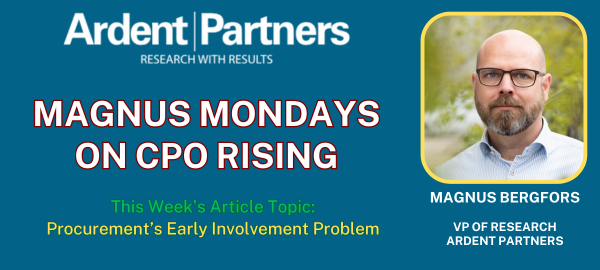One of the longest-standing complaints from procurement professionals I’ve heard throughout my 20+ year career is: “we don’t get involved early enough.” The complaint certainly has merit. The earlier sourcing professionals can get involved, the more opportunity they have to ensure proper cost control and avoid overreliance of specific suppliers. With that said, what are procurement professionals actually doing to get earlier involvement?
While some mature procurement organizations, through built-up credibility and established stakeholder collaboration often via category management, are successful with early involvement, most still struggle in this area. Certainly, focusing on building trust and strong relationships is recommended, but there’s also a procurement technology component as well. How can tech help with earlier and better collaboration with stakeholders?
S2P is Too “Inward Looking”
Traditional S2P has almost exclusively been designed and built for procurement. While solutions like eSourcing or contract management enable collaboration, stakeholders must login in to the procurement solution to do so. And even with a single sign-on (hopefully), it still means a new solution to learn and remember. Stakeholders also need to be invited and can’t submit requests or kick-off initiatives. In the S2P scenario, the P2P or eProcurement module is usually meant as the starting point for non-procurement users, but this leaves a lot to be desired when it comes to flexibility and collaboration capabilities.
A well-configured P2P system could direct stakeholders to the correct system or person if searching for something not purchased through the P2P system. However, most searches will come up empty, requiring the end user to use a different system or seek assistance.
There is also the issue of processes that must use other systems outside of procurement. A common example is IT security, where software security evaluation and approval must occur before usage. Thus, a request to purchase new software must be approved but also evaluated. Today’s P2P systems, however, only address the approval step.
That said, S2P suite providers are starting to address some of these issues with AI agents and their own intake management and orchestration modules or capabilities. This leads us to the next question.
Is Intake and Orchestration the Answer?
Early engagement and collaboration between stakeholders and procurement is basically the reason the intake and orchestration market exists. For example, Zip, a pioneer in this space, was founded out of the frustration of its founders (who actually didn’t work in procurement) when they tried to collaborate with procurement. One of the features of such solutions is that they provide a single starting point for end users, regardless of what they need. This makes it easy for end users to engage with procurement early. Flexible workflows and custom-designed forms ensure that the right information is captured early and without a need to constantly go back and forth.
Now this doesn’t automatically mean earlier procurement involvement, but it at least provides a better and simpler interface for end users to get started. With a single-entry point, they don’t need to know who or what system to start with based on the type of request and spend category. But they still need to submit the request, leading us back to building procurement’s credibility and reputation of adding value to the process. Making it as simple as possible for the end users is certainly one important piece of the puzzle.
As always, Ardent Partners is here to help and answer any questions you may have!
RELATED RESEARCH
Will 2024 be the “Year of Intake Management and Procurement Process Orchestration?”
Magnus Mondays — Graphite Connect: Supplier Management, Network Style

